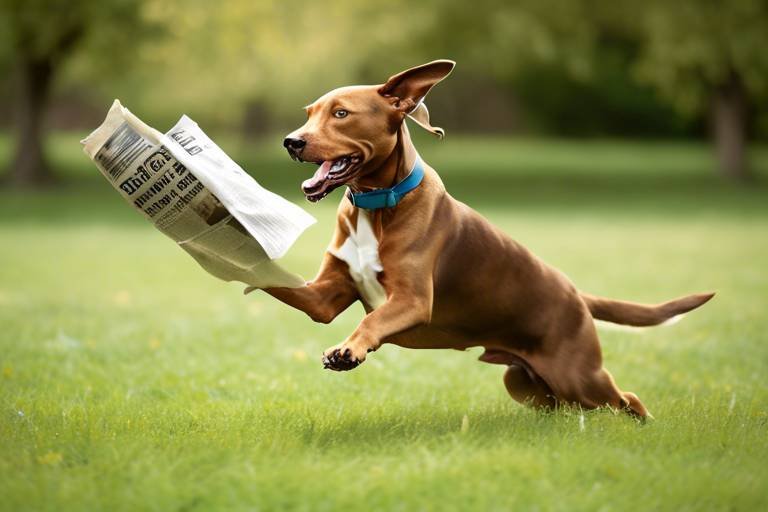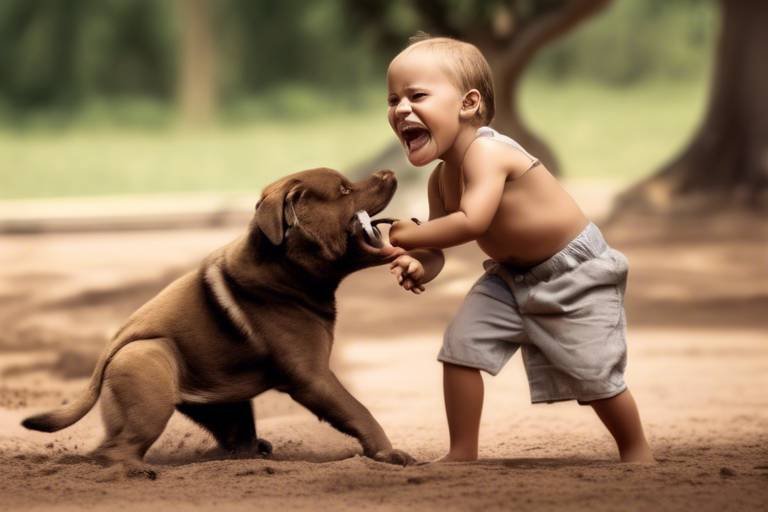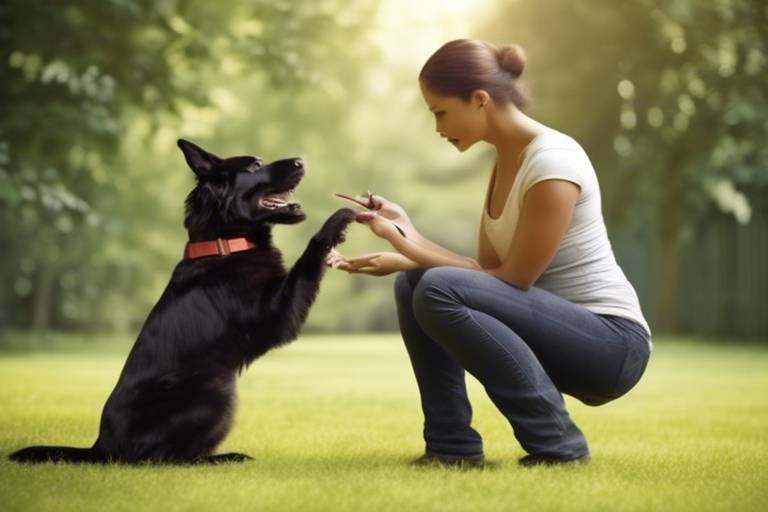How to Teach Your Dog to Fetch the Newspaper
This article provides a step-by-step guide on training your dog to fetch the newspaper, enhancing your dog's skills while also promoting exercise and bonding between you and your pet. Imagine waking up to the crisp morning air, your dog eagerly waiting by the door, ready to dash outside and retrieve the newspaper for you. Not only does this task add a fun twist to your morning routine, but it also gives your furry friend a sense of purpose and accomplishment. So, let’s dive into the exciting world of dog training and turn your pup into a newspaper-fetching superstar!
To effectively train your dog, it's important to understand what motivates them. Dogs are driven by various incentives, and knowing what makes your pup tick can be the key to successful training. Is your dog food-driven? Then treats might be the best reward. Does your dog love playtime? A favorite toy could be the perfect incentive. Understanding these motivations allows you to tailor your training approach. For example, if your dog gets excited about chasing balls, you might find that using a ball as a reward during training sessions could enhance their eagerness to learn. Remember, every dog is unique, and discovering what drives your furry friend will make the training process not just easier but also more enjoyable.
Selecting the appropriate newspaper is crucial for training. You don’t want to overwhelm your dog with a heavy, large paper that could discourage them. Instead, opt for something lightweight and easy to carry. Local community newspapers or smaller publications can be ideal choices. Additionally, consider the material; some newspapers have glossy finishes that could be slippery and hard for your dog to grip. Preparing the newspaper for your dog involves ensuring it’s in good condition—no torn edges or excessive ink that could stain their paws. A well-prepared newspaper will not only make fetching easier but also keep your dog engaged and excited about the task.
Understanding the size and weight of the newspaper is essential. A paper that is too large or heavy can discourage your dog from fetching it. Ideally, the newspaper should be light enough for your dog to carry comfortably in their mouth. For smaller breeds, a standard-sized newspaper might be too cumbersome, while larger breeds might need a thicker paper to satisfy their fetching instincts. Always keep your dog’s size in mind when choosing the newspaper, and don’t hesitate to cut it down to a manageable size if necessary. This simple adjustment can make a huge difference in your dog’s willingness to fetch.
Before training begins, it's important to introduce your dog to the newspaper. Start by letting your dog sniff and explore the paper. You can even play a little tug-of-war with the newspaper to pique their interest. This technique not only familiarizes your dog with the item but also makes it a fun experience. Gradually, you can toss the newspaper a short distance and encourage your dog to chase after it. This initial exposure helps your dog associate the newspaper with positive experiences, making them more eager to fetch it during training sessions.
Teaching basic commands is vital for successful fetching. Commands like 'fetch' and 'drop' are essential for guiding your dog during the training process. Start by using a clear and enthusiastic tone when giving these commands. For instance, when you throw the newspaper, say “fetch!” in an excited voice to encourage your dog to chase after it. Once your dog picks it up, use the command “drop” when they return. It’s important to be consistent with these commands, as repetition will help your dog learn them more effectively. Remember, patience is key—every dog learns at their own pace.
These two commands are fundamental for fetching. To teach 'fetch,' start by tossing the newspaper a short distance. When your dog picks it up, praise them enthusiastically. Gradually increase the distance as your dog becomes more comfortable with the command. For 'drop,' gently encourage your dog to let go of the newspaper by offering a treat or another toy as a trade. When they drop the newspaper, shower them with praise! This positive reinforcement helps solidify their understanding of the commands and makes the training process enjoyable for both of you.
Positive reinforcement plays a key role in training. Using treats, verbal praise, or playtime as rewards encourages your dog to repeat the desired behavior. Every time your dog successfully fetches the newspaper, reward them immediately. This creates a strong association between fetching the newspaper and receiving a reward. Over time, your dog will look forward to the task, eager to impress you with their fetching skills. Remember, the more positive experiences your dog has while training, the more motivated they will be to learn.
Consistency is key in any training regimen. Set aside time each day to practice fetching with your dog. Regular practice not only reinforces the commands but also keeps your dog engaged and excited about the task. Vary the location and time of day to keep things interesting. You can even incorporate fetching into your daily routine, like having your dog fetch the newspaper every morning. This not only builds a habit but also strengthens the bond between you and your furry friend. Remember, training should be fun—both for you and your dog!
Training can come with its challenges. You might encounter issues such as your dog being easily distracted or not returning the newspaper. If your dog seems uninterested, try using a more exciting reward or changing the environment. Sometimes, a noisy or busy area can distract your dog from the task at hand. If your dog doesn’t return the newspaper, practice the 'come' command separately and reinforce it with treats. With patience and persistence, you’ll overcome these hurdles and enjoy the rewarding experience of a well-trained fetching companion.
- How long does it take to teach my dog to fetch the newspaper? The time it takes varies by dog, but with consistent practice, many dogs can learn within a few weeks.
- What if my dog loses interest in fetching? Try changing the reward or introducing new commands to keep their interest alive.
- Can all dogs learn to fetch? Most dogs can learn to fetch, but some breeds may require more patience and different training techniques.
Understanding Your Dog's Motivation
When it comes to training your dog to fetch the newspaper, understanding what motivates your furry friend is key. Every dog is unique, and their motivations can vary widely. Some dogs may be driven by food rewards, while others might be more excited by playtime or praise from their owner. Think of it like this: just as different people are inspired by different things, your dog has its own set of preferences that can make training more effective.
To kick off your training journey, consider these common motivators:
- Food Treats: Many dogs will do just about anything for a tasty treat. Using small, high-value snacks can help keep their attention focused on the task at hand.
- Toys: If your dog loves to play, consider using their favorite toy as a reward. This can make fetching even more exciting.
- Praise and Affection: Sometimes, all your dog wants is a little love and attention. Verbal praise and petting can go a long way in reinforcing good behavior.
Additionally, understanding your dog's breed can provide insight into their natural instincts. For instance, retrievers are often more inclined to fetch due to their innate desire to retrieve objects. On the other hand, breeds with a strong prey drive might be more inclined to chase rather than bring back. Knowing these traits can help you tailor your training approach.
Another important factor to consider is your dog's energy level. High-energy dogs may require more vigorous activities to keep them engaged, while more laid-back pups might prefer a gentler approach. Observing your dog during playtime can give you clues about their energy levels and preferences, allowing you to adjust your training methods accordingly.
Finally, don’t forget about the emotional aspect of training. Dogs are social animals that thrive on interaction. If your dog sees fetching the newspaper as a fun game that involves you, they’ll be more likely to participate enthusiastically. Make sure to keep the atmosphere light and enjoyable, and don't forget to celebrate small victories along the way. After all, training should be a bonding experience, not a chore!
Choosing the Right Newspaper
When it comes to teaching your dog to fetch the newspaper, selecting the right type of newspaper is not just a trivial detail; it can significantly impact your training success. Not all newspapers are created equal! Some are too heavy, while others might be too crinkly or large for your furry friend. So, how do you choose the perfect one? Let's dive into the details.
First and foremost, consider the size of the newspaper. A standard-sized newspaper can be quite overwhelming for smaller breeds, while larger breeds might find it too easy to handle. If your dog is on the smaller side, you might want to opt for a tabloid-sized newspaper or even a folded version of a regular one. This will make it manageable and encourage them to participate without feeling intimidated.
Next, think about the weight of the newspaper. A hefty newspaper can be a challenge for your dog, especially if they are not used to carrying things in their mouth. Look for newspapers that are lightweight and easy to pick up. You want something that your dog can carry without dragging it on the ground. If you find a newspaper that is too heavy, consider tearing it into smaller sections. This way, it becomes easier for your dog to fetch without losing interest.
Another important factor to take into account is the texture of the newspaper. The sound of crinkling paper can be exciting for some dogs, while others may find it intimidating. If you notice your dog is hesitant to pick up the newspaper, try introducing them to a different type. You can even use old magazines or lightweight flyers as an alternative to see what your dog prefers. The goal is to find something that excites them and makes them eager to fetch.
Lastly, it's essential to keep in mind the familiarity of the newspaper. If you regularly receive a particular publication, stick with that one, as your dog will become accustomed to its smell and feel. Familiarity can help build confidence during training sessions. You can also use the same newspaper consistently throughout the training process, as this will help your dog associate that specific item with fetching.
In summary, choosing the right newspaper for your dog's fetching training involves a few key considerations:
- Size: Opt for smaller, manageable sizes for smaller breeds.
- Weight: Lightweight options are ideal to keep your dog engaged.
- Texture: Select a texture that your dog is comfortable with.
- Familiarity: Stick to the same publication to build confidence.
By paying attention to these factors, you'll set the stage for a successful and enjoyable training experience. Remember, the right newspaper can make all the difference in your dog’s enthusiasm and ability to fetch!
Size and Weight Considerations
When it comes to teaching your dog to fetch the newspaper, size and weight are critical factors that can significantly influence your dog's ability to perform the task successfully. Imagine trying to lift a heavy suitcase when you're only used to carrying a light backpack; similarly, if the newspaper is too large or heavy for your dog, it may become discouraged or even refuse to participate in the activity altogether. Therefore, it's essential to choose a newspaper that aligns with your dog's physical capabilities.
Generally, you want to select a newspaper that is manageable for your dog to carry. For smaller breeds, a lightweight tabloid or a single section of a larger newspaper may be the best option. Larger breeds, on the other hand, can typically handle a full-size newspaper without any issues. Here’s a quick breakdown:
| Dog Size | Recommended Newspaper Size | Weight Considerations |
|---|---|---|
| Small Breeds (e.g., Chihuahua, Pomeranian) | Tabloid or half-size | Lightweight (under 0.5 lbs) |
| Medium Breeds (e.g., Beagle, Bulldog) | Full-size, but not too thick | Moderate weight (0.5 - 1 lb) |
| Large Breeds (e.g., Labrador, German Shepherd) | Full-size | Heavier (1 lb or more) |
In addition to size and weight, consider the texture of the newspaper. Some dogs may find crinkly or glossy paper more appealing, while others might prefer something softer. Experimenting with different types can help you find the right fit for your furry friend. Remember, the goal is to make fetching an enjoyable experience, not a chore.
Lastly, keep in mind that as your dog practices fetching the newspaper, their strength and confidence will grow, allowing them to handle larger or heavier editions over time. Just like a child learning to ride a bike, they may start with training wheels (or in this case, a lighter newspaper) and gradually progress to the real deal as they become more skilled. So, always start with what your dog can handle and adjust as they improve!
- How long does it take to teach my dog to fetch the newspaper? The time varies depending on the dog’s age, breed, and previous training experience. Most dogs can learn the basics in a few weeks with consistent practice.
- What if my dog is not interested in fetching? Try using different rewards or toys to spark their interest. Sometimes, a little creativity can go a long way!
- Can I use a different item instead of a newspaper? Absolutely! You can use any lightweight object that your dog can carry, such as a ball or a soft toy.
Familiarizing Your Dog with the Newspaper
Before diving into the actual training of fetching the newspaper, it’s crucial to help your furry friend get acquainted with this new object. Think of this stage as laying the foundation for a beautiful house; if the base isn’t solid, everything else may tumble down. Start by introducing the newspaper in a calm and positive environment. You want to create a sense of curiosity and excitement around the newspaper, rather than fear or anxiety.
Begin by letting your dog sniff and explore the newspaper. You can place it on the floor and encourage your dog to approach it. Use a friendly tone and perhaps a treat to entice them closer. You might say something like, “What’s this? It’s just a piece of paper!” This will help them associate the newspaper with positive experiences. If your dog seems hesitant, don’t force them; instead, give them some time to investigate at their own pace. Remember, patience is key!
Once your dog seems comfortable with the newspaper, you can take it a step further. Start by gently tossing the newspaper a short distance away. This is where you can gauge their interest. If they show enthusiasm and go after it, that’s a great sign! If they don’t seem interested, try crumpling the newspaper slightly to make it more appealing. Dogs are often attracted to movement and sounds, so the crinkling noise might pique their curiosity.
It’s also helpful to incorporate some fun into the process. You can play a game of tug-of-war with the newspaper, which will not only make them more familiar with it but also strengthen your bond. Just be sure to supervise this closely, as you don’t want your dog to tear it apart completely! After all, we want them to fetch it, not shred it to bits.
As your dog becomes more comfortable, you can start using commands like “bring” or “fetch” when they pick it up. This will help them connect the action of retrieving the newspaper with the command you want them to learn. Consistency is crucial here. The more positive interactions they have with the newspaper, the more likely they will be to enjoy fetching it later on.
In summary, familiarizing your dog with the newspaper is all about creating a positive association. Use treats, play, and gentle encouragement to help them see the newspaper as a fun and exciting object rather than just a piece of paper. Once they are comfortable, the actual training will become a much smoother process!
- How long does it take to train my dog to fetch the newspaper? The time can vary greatly depending on your dog's personality, age, and prior training. Some dogs may pick it up within a few days, while others may take weeks.
- What if my dog is scared of the newspaper? If your dog shows fear, take a step back. Use treats and positive reinforcement to encourage them to approach it slowly.
- Can all dogs learn to fetch the newspaper? Most dogs can learn this skill, but some breeds may be more inclined to fetch than others. It’s important to tailor your training approach to your dog’s personality.
- What should I do if my dog refuses to drop the newspaper? If your dog holds onto the newspaper too tightly, you can teach the command “drop” by offering a treat in exchange for the newspaper.
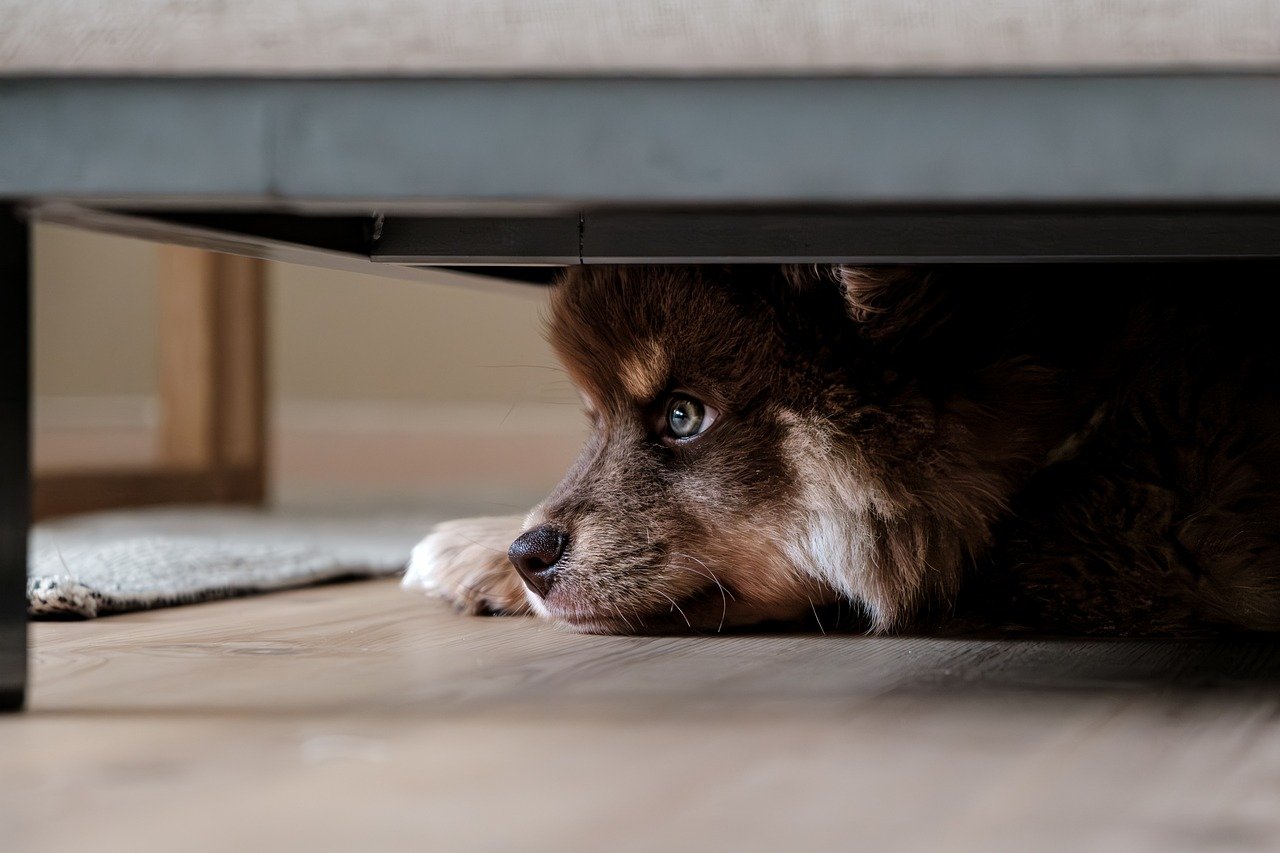
Basic Commands for Fetching
Teaching your dog to fetch the newspaper is not just about throwing a piece of paper and expecting them to bring it back. It involves understanding and implementing some basic commands that will guide your furry friend through the process. These commands create a foundation for your dog's fetching skills and ensure that they know exactly what you want from them. The two most essential commands in this context are 'Fetch' and 'Drop'. Let’s dive into how to teach these commands effectively!
The first command, 'Fetch', is the gateway to your dog understanding the game. To teach this command, start by using a toy or the newspaper itself. Show your dog the item, and with enthusiasm, say the word 'Fetch' as you throw it a short distance. It’s crucial to use a cheerful tone that conveys excitement—dogs are incredibly perceptive to our emotions! When your dog picks up the item, encourage them to return it to you with a happy voice. If they don’t come back right away, don’t fret! Use treats or their favorite toy to coax them back. The goal here is to associate the command 'Fetch' with the action of retrieving.
Once your dog has grasped the idea of fetching, it's time to introduce the second command: 'Drop'. This command is vital for ensuring that your dog releases the newspaper when they bring it back. To teach this, wait until your dog approaches you with the newspaper in their mouth. Hold out a treat and say 'Drop' in a firm but friendly voice. Most dogs will instinctively drop the item to take the treat. When they do, praise them enthusiastically! It’s all about creating positive associations. Over time, they will learn to drop the newspaper on command without needing a treat every time.
Consistency is critical when teaching these commands. Make sure to practice regularly and in various environments to help your dog generalize the commands. Remember, training should be a fun experience for both you and your dog. If they seem bored or frustrated, take a break and try again later. Dogs, much like humans, can have off days! The more you practice, the more your dog will understand and respond to the commands, making the fetching process smoother and more enjoyable.
To summarize, here are the key points to remember when teaching basic commands for fetching:
- 'Fetch' involves excitement and encouragement.
- 'Drop' should be associated with treats and praise.
- Practice regularly to reinforce learning.
- Keep training sessions fun to maintain your dog's interest.
By focusing on these basic commands, you're not only teaching your dog how to fetch the newspaper but also enhancing your bond with them. Remember, patience and positivity are your best friends in this training journey!
Q: How long does it take to teach my dog to fetch the newspaper?
A: The time it takes can vary greatly depending on your dog's age, breed, and previous training. Some dogs may pick it up in a few sessions, while others may take several weeks. Consistency and patience are key!
Q: What if my dog is not interested in fetching?
A: Not all dogs have a natural inclination to fetch. You may need to find a more enticing item, like a squeaky toy, or incorporate playtime into the training to spark their interest.
Q: Can I train my dog to fetch other items besides the newspaper?
A: Absolutely! Once your dog has mastered fetching the newspaper, you can easily transition to other items like a ball, frisbee, or even your slippers!
Teaching 'Fetch' and 'Drop'
Teaching your dog the commands 'Fetch' and 'Drop' is crucial for a successful newspaper fetching routine. These commands not only help your dog understand what you want them to do, but they also create a fun and engaging game that strengthens your bond. So, how do you go about teaching these commands effectively? Let's break it down into manageable steps!
First off, begin with the 'Fetch' command. Start by holding the newspaper in front of your dog, ensuring they are excited and curious about it. You might want to give it a little shake to grab their attention. Once they show interest, throw the newspaper a short distance away. As soon as your dog runs after it, enthusiastically say 'Fetch'! This is where their natural instincts kick in, and they will likely pick it up. If they do, praise them immediately! Your excitement will encourage them to associate the command with the action.
Now, here’s where it gets interesting. If your dog picks up the newspaper but doesn’t bring it back, you can use a little trick. Start calling them back with an inviting tone, saying 'Come' or 'Bring it here'. When they return with the newspaper, reward them with treats or their favorite toy. This positive reinforcement is key! Dogs thrive on praise and rewards, and it solidifies the connection between the command and the action.
Once your dog gets the hang of fetching the newspaper, it’s time to introduce the 'Drop' command. This can be a bit tricky, but with patience, your dog will master it. When your dog returns with the newspaper, hold a treat close to their nose and say 'Drop'. The moment they drop the newspaper to get the treat, shower them with praise! Repeat this process several times until they start to drop the newspaper on command without needing the treat as a lure.
Here’s a little tip: practice makes perfect! Make sure to practice these commands in short, fun sessions. Dogs have short attention spans, so keeping it light and engaging will help maintain their interest. You can gradually increase the distance you throw the newspaper as your dog becomes more confident in their fetching abilities. With time, they’ll learn that the 'Fetch' and 'Drop' commands lead to fun playtime and tasty rewards!
Remember, patience is key. If your dog struggles with these commands, don’t get frustrated. Every dog learns at their own pace, and the more positive experiences you create, the more eager they will be to learn. Building a strong foundation with these commands will make your training sessions enjoyable and effective!
Using Positive Reinforcement
When it comes to training your dog to fetch the newspaper, positive reinforcement is your best friend. This method relies on rewarding your furry companion for good behavior, which not only makes the training process enjoyable but also strengthens the bond between you and your pet. Imagine this: instead of just saying “no” when your dog doesn’t fetch, you’re showering them with praise and treats when they do! It’s like throwing a mini party every time they get it right.
So, how do you effectively implement positive reinforcement in your training sessions? First, you need to identify what motivates your dog the most. For some pups, it might be their favorite treat, while others might respond better to playtime or a good belly rub. Here are a few tips to keep in mind:
- Timing is Everything: Make sure to reward your dog immediately after they perform the desired action. This helps them associate the behavior with the reward.
- Keep It Consistent: Use the same rewards each time to avoid confusing your dog. If they know that fetching the newspaper leads to a tasty treat, they’ll be more inclined to repeat the behavior.
- Mix It Up: While consistency is important, don’t hesitate to vary the rewards occasionally. This keeps things exciting for your dog and can motivate them to work harder.
For instance, if your dog successfully brings back the newspaper, you might say, “Good boy!” while giving them a treat. Over time, they’ll learn that fetching the newspaper is a surefire way to earn some delicious snacks and your affection. It’s like a game of fetch with a twist—every successful retrieve earns them a reward!
Additionally, you can use a mix of verbal praise and physical affection to reinforce their behavior. Dogs are social animals, and they thrive on attention from their owners. So, don’t underestimate the power of a good scratch behind the ears or an enthusiastic “You did it!”
As you progress, you may want to introduce a clicker into your training routine. A clicker is a small device that makes a distinct sound when pressed, and it can be a powerful tool for marking the exact moment your dog performs the desired behavior. This creates a clear connection between the action and the reward, making it easier for your dog to understand what you expect from them.
In summary, using positive reinforcement is not just about treats; it’s about creating a fun and rewarding experience for your dog. By focusing on their successes and celebrating each milestone, you’re not only teaching them to fetch the newspaper but also building a relationship based on trust and enjoyment. It’s a win-win situation for both of you!
Q1: How long should I train my dog each day?
A1: Aim for short, frequent sessions of about 5-10 minutes, several times a day. Dogs have short attention spans, so keeping training sessions brief helps maintain their interest.
Q2: What if my dog doesn’t seem interested in fetching the newspaper?
A2: It’s essential to ensure your dog is motivated. Try different rewards, such as toys or treats, and make the newspaper more appealing by playing with it before introducing it during training.
Q3: Can I use this method for other commands?
A3: Absolutely! Positive reinforcement is effective for teaching a variety of commands and behaviors, not just fetching.
Q4: How do I know when my dog has mastered fetching the newspaper?
A4: If your dog consistently retrieves the newspaper and brings it back to you on command, they’ve likely mastered the skill. You can gradually reduce the frequency of rewards as they become more proficient.
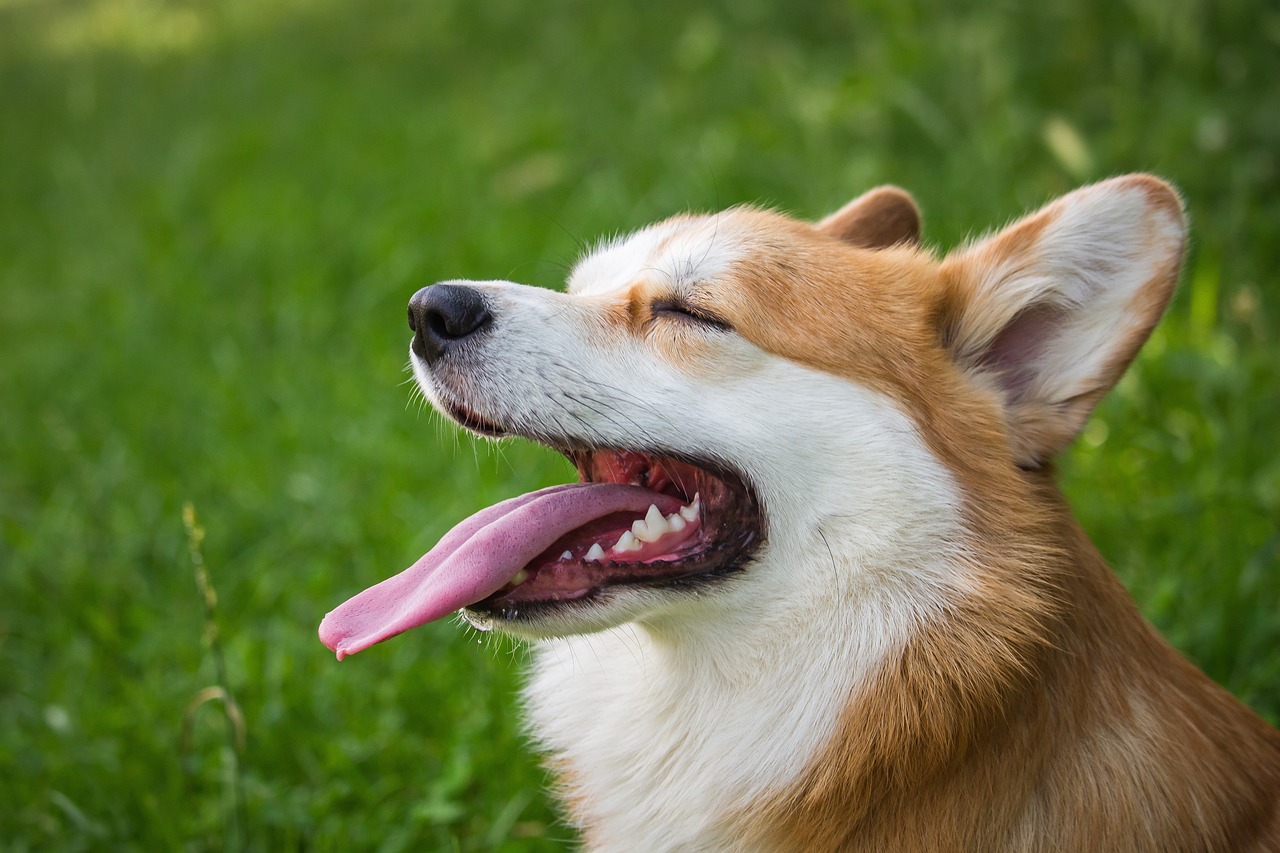
Practicing and Building Consistency
When it comes to teaching your dog to fetch the newspaper, practice and consistency are your best friends. Just like humans, dogs thrive on routine and repetition. Imagine trying to learn a new skill without ever practicing it; it would be nearly impossible, right? The same applies to your furry friend. By establishing a regular fetching routine, you’ll not only help your dog master the skill but also create a fun bonding experience that strengthens your relationship.
Start by setting aside a specific time each day dedicated to fetching practice. This could be as simple as a few minutes in the morning before you start your day or during the evening when you’re winding down. The key is to make it a regular part of your dog’s schedule. Dogs are creatures of habit, and they will look forward to this time with you, eagerly anticipating the fun that lies ahead.
During your practice sessions, keep the atmosphere positive and upbeat. Use an enthusiastic voice when encouraging your dog, and don’t forget to reward them with treats and affection when they successfully fetch the newspaper. This positive reinforcement is crucial as it helps your dog associate the fetching activity with good feelings. You might find that your dog becomes more motivated to fetch when they see you excited and ready to play.
Consistency doesn’t just apply to the frequency of practice; it also extends to your commands and expectations. Always use the same command words for fetching, like “fetch” and “drop.” This repetition will help your dog learn to associate these words with the actions you want them to perform. If you change commands frequently or use different tones, it can confuse your dog, making the training process longer and more frustrating for both of you.
As your dog becomes more comfortable with fetching the newspaper, gradually increase the difficulty of the task. For example, you can start by tossing the newspaper just a few feet away and then gradually increase the distance as your dog improves. This not only keeps your dog engaged but also challenges them, which is essential for mental stimulation. Remember, practice makes perfect, and the more you practice, the better your dog will become!
To help you keep track of your progress and maintain consistency, consider creating a simple practice log. You can use a table like the one below to note the date, duration of each session, and any observations about your dog's performance:
| Date | Duration (minutes) | Observations |
|---|---|---|
| MM/DD/YYYY | 10 | Dog fetched successfully 5 times! |
| MM/DD/YYYY | 15 | Struggled with the drop command. |
Incorporating a practice log can help you identify patterns in your dog’s learning and areas that might need more attention. Just like any other training, the journey of teaching your dog to fetch the newspaper will have its ups and downs. But with patience, dedication, and a sprinkle of fun, you’ll not only teach your dog a valuable skill but also create memories that you both will cherish.
Q: How long should each practice session be?
A: Start with short sessions of about 5-10 minutes and gradually increase as your dog becomes more comfortable and engaged.
Q: What if my dog doesn’t want to fetch the newspaper?
A: Make sure the newspaper is appealing to your dog and use positive reinforcement to encourage them. Sometimes, a little playfulness can spark their interest!
Q: Can I train an older dog to fetch the newspaper?
A: Absolutely! Dogs of all ages can learn new tricks. Just be patient and adjust the training to suit their energy levels and abilities.

Common Challenges and Solutions
Training your dog to fetch the newspaper can be a delightful experience, but it often comes with its fair share of challenges. Just like humans, dogs have their unique personalities, and some may take to fetching like a duck to water, while others might need a bit more coaxing. One common challenge is a lack of interest in the newspaper itself. If your dog seems more interested in chasing butterflies or sniffing the grass, it’s time to rethink your approach. You might want to consider using a toy that resembles a newspaper or even incorporating a treat inside the rolled-up paper to pique their curiosity.
Another frequent issue is the dog’s tendency to run off with the newspaper instead of bringing it back to you. This can be frustrating, but it’s crucial to remember that your dog is simply following their instincts. To counter this, you can use the 'fetch' command effectively. Start by throwing the newspaper a short distance and encouraging your dog to bring it back. When they do, shower them with praise or a treat to reinforce the behavior. Consistency is key here; if they keep running off, gently redirect them back to you and reward them for returning the item.
Sometimes, dogs may also struggle with the 'drop' command, which is essential for this training. If your dog is reluctant to let go of the newspaper, try using a second toy or treat as a trade-off. Show them the new item and encourage them to drop the newspaper in exchange. This method not only teaches them the 'drop' command but also makes the process fun and engaging. Remember, patience is crucial. If your dog seems frustrated or overwhelmed, take a break and try again later. Training should be a fun bonding experience, not a chore.
Here are some common challenges along with their solutions:
| Challenge | Solution |
|---|---|
| Lack of Interest | Use a toy or treats to make the newspaper more appealing. |
| Running Off with the Newspaper | Use the 'fetch' command consistently and reward them for returning. |
| Reluctance to Drop | Trade the newspaper for a toy or treat to encourage dropping it. |
Lastly, don’t forget that every dog is different. What works for one might not work for another. Keep experimenting with different techniques and approaches until you find what resonates with your furry friend. Training is as much about building a bond as it is about teaching skills, so enjoy the journey together!
Q: How long does it take to train my dog to fetch the newspaper?
A: The time it takes varies by dog. Some may learn in a few sessions, while others might take weeks. Consistency and patience are key!
Q: What if my dog doesn't want to fetch at all?
A: Try using different items or toys that your dog finds more interesting. Sometimes, a little creativity can make all the difference!
Q: Can I train an older dog to fetch the newspaper?
A: Absolutely! Older dogs can learn new tricks, too. Just be mindful of their physical limitations and adjust your training accordingly.
Q: Should I always use treats during training?
A: While treats can be effective, it's also important to mix in verbal praise and affection. This helps build a positive association with the training process.
Frequently Asked Questions
- How long does it take to train my dog to fetch the newspaper?
The time it takes to train your dog can vary widely depending on their age, breed, and prior training experience. Generally, with consistent practice and positive reinforcement, you can expect to see progress within a few weeks. Just remember, patience is key!
- What if my dog doesn't seem interested in fetching the newspaper?
If your dog isn't interested, it might be a good idea to explore different motivations. Some dogs respond well to treats, while others may prefer toys or praise. Try to find what excites your pup and use that as a reward during training!
- Can any dog learn to fetch the newspaper?
Most dogs can learn to fetch, but some breeds may be more inclined to enjoy it than others. Dogs with a natural retrieving instinct, like Retrievers and Spaniels, often take to fetching like ducks to water. However, with the right training techniques, even less enthusiastic dogs can learn!
- What size newspaper should I use for training?
Choosing the right size of newspaper is crucial. Ideally, you want a lightweight newspaper that is easy for your dog to carry. A standard-sized newspaper works well for most medium to large dogs, while smaller breeds may benefit from a half-sized version.
- How do I introduce my dog to the newspaper?
Start by allowing your dog to sniff and explore the newspaper without any pressure. You can also use treats to create a positive association. Once they seem comfortable, you can begin the actual training process!
- What commands should I teach my dog for fetching?
The two essential commands are 'Fetch' and 'Drop.' Start with 'Fetch' to encourage your dog to go after the newspaper and 'Drop' to prompt them to release it back to you. Consistent practice will help reinforce these commands.
- How can I keep my dog motivated during training?
Mixing up your training routine can keep things exciting! Use different newspapers, change the location, or even vary the rewards you offer. Keeping the sessions short and fun will help maintain your dog's interest!
- What should I do if my dog refuses to drop the newspaper?
If your dog is reluctant to drop the newspaper, try using a trade-off approach. Offer a treat or toy in exchange for the newspaper. This method can help them understand that dropping the item leads to something rewarding!
- Are there any common mistakes to avoid during training?
Absolutely! One common mistake is being inconsistent with commands or rewards. Another is pushing your dog too hard, which can lead to frustration. Always keep training sessions positive and end on a high note!
- How often should I practice fetching with my dog?
Consistency is vital! Aim for short, daily training sessions of about 10-15 minutes. This frequency helps reinforce learning without overwhelming your dog. Just like us, dogs thrive on routine!

